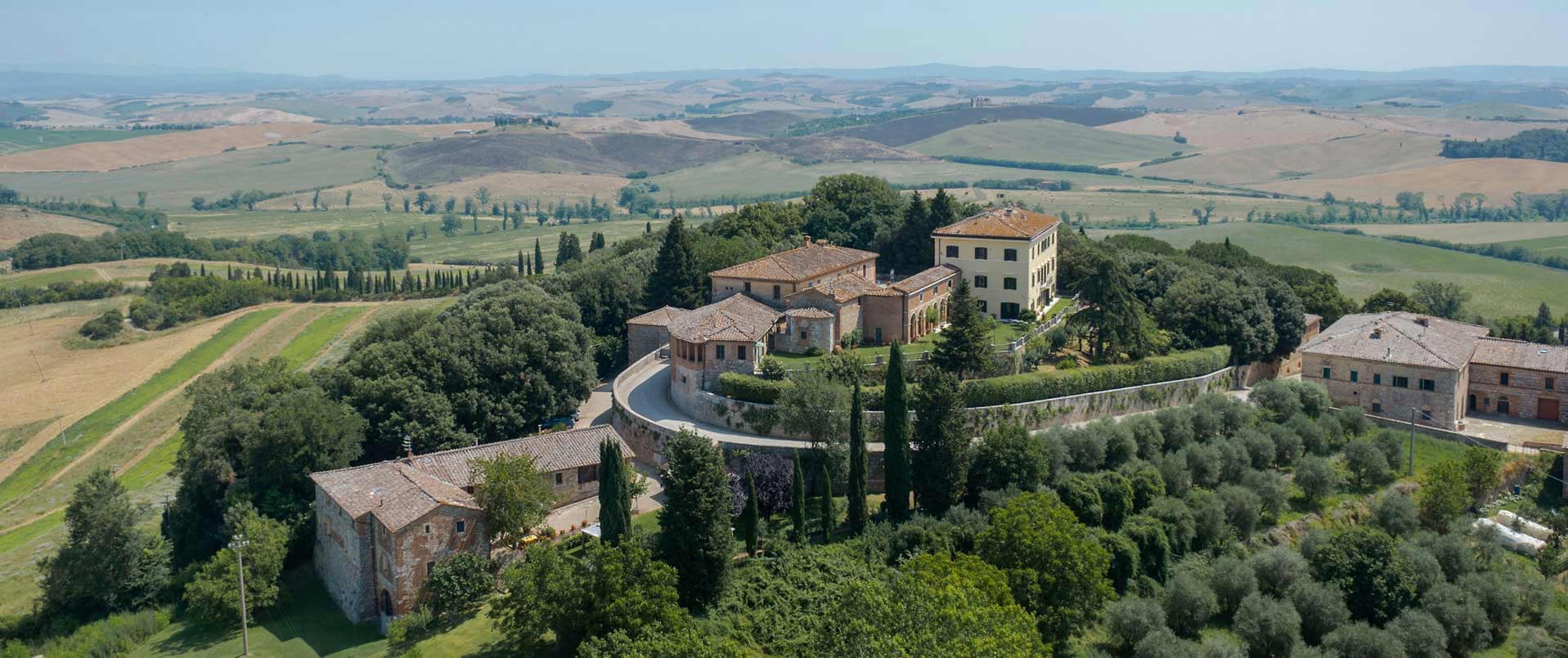
CIN Code: Appartamento Camilla CIN: IT006127C2H6HAXTKN; Appartamento Margherita CIN: IT006127C2RSXFX9WT; Appartamento Lodovica CIN: IT006127C2CVHRXIZB
Castello di Pasturana
Nestled in one of the most picturesque landscapes of the lower Piedmont region, the castle of Pasturana is a unique location that combines romance and elegance, offering well-kept and welcoming indoor and outdoor spaces for a special experience.
Located on the hills behind Novi Ligure, it overlooks the valleys between Lemme, Orba, and Scrivia, offering an exceptional view that, on clear days, embraces the Apennines, Alps, and the vast Po Valley.
Upon entering the access gate, you’ll find a colonnaded porch flanked by the old castle tower, the oldest part of the entire residence, alongside a small greenhouse. Following the gravel path, you’ll cross four gardens “all’italiana” outlined by hedges and flower beds that lead to the woods.
The main façade of the building features traces of a three-arched loggia and large windows reminiscent of the architectural styles of the periods of Louis XIII and Louis XIV. In the corners, four guard towers testify to its ancient fortified function.
A grand staircase adorned with cherubs and a baroque-style door characterize the entrance to the courtyard, a spacious area where you’ll find access to the consecrated chapel and the residence.
Inside, you’ll find large and numerous halls, living quarters, spacious kitchens, and facilities. The halls and lounges offer warm and comfortable environments to host events in all seasons.
Public Opening
The Castle of Pasturana is open to the public every year in celebration of St. Anna, the patron saint of the village. During this occasion, the castle hosts a classical music concert in the inner courtyard, organized by the local Pro Loco.
Hospitality
The castle features three charming, recently renovated apartments located on the first and second floors, with the first two accessible via a dedicated elevator. Each apartment is equipped with internet, air conditioning, and heating to ensure comfort in every season.
– Margherita Apartment (First Floor)
This cozy apartment includes a living room with a kitchenette, two double bedrooms, and a bathroom, making it perfect for an intimate and relaxing stay.
– Lodovica Apartment (Second Floor)
Similar in design, the Lodovica apartment offers a living room with a kitchenette, two double bedrooms, and a bathroom, combining elegance and functionality.
– Camilla Apartment (Noble Floor)
The Camilla apartment has dedicated access via a private staircase and consists of three bedrooms, three bathrooms, a kitchen, a dining room, and a large living room.
Events
The Castle of Pasturana hosts private and corporate events, as well as religious and civil weddings. The property is available to assist you in planning your event, suggesting ideal solutions for every phase and type of occasion.
History
The first record attesting to the existence of Pasturana dates back to 981. Under the name “Pastorianum,” the locality is mentioned in an imperial diploma issued in favor of the Monastery of San Salvatore di Pavia. In the early centuries, Pasturana was part of the territory of Tortona.
As time went on, the small village followed the fortunes of the communities of the so-called Oltregiogo, with its dominion alternating between the State of Milan, the Republic of Genoa, and the Marquisate of Monferrato. Although administratively part of Piedmont today, Pasturana has always orbited between the Ligurian maritime power and the flourishing Lombard duchy, with claims also made by the Monferrato Paleologi.
Pasturana is among the numerous fiefs that Emperor Henry VII (the Arrigo whom Dante Alighieri places in Paradise) grants to Opizzino Spinola of the Luccoli branch in 1313. If this event marks a fundamental stage for the ancient Genoese family in terms of consolidating its position beyond the borders of the Republic, for Pasturana, it was not the beginning of greater stability, as confirmed by the fact that just twenty years later, the locality and its inhabitants had to swear allegiance to Marquess Giovanni Paleologo.
The Fifteenth and Sixteenth Centuries: the Trotti family of Alessandria
The fifteenth century does not start well for Pasturana. In the early years of the century, it is indeed a victim of the looting carried out by the troops following the famous condottiero Facino Cane, who, complicit in the crisis triggered by the death of Gian Galeazzo Visconti, the first duke of Milan, sought to find his own personal state. In his advance, the captain also subdues Tortona and Alessandria.
During the fifteenth century, the fortunes of Pasturana are linked to the city that is now the provincial capital. Foiled the attempt by Facino Cane and returned to the possessions of the Duchy of Milan, on January 30, 1430, the village is granted through investiture to Franceschino de’ Trotti of Alessandria and his son Bongiovanni with the right of succession in the line of primogeniture.
The Trotti lordship lasts for almost two centuries: in 1555, the investiture is renewed by the future King of Spain Philip II, at that time still a prince, to the brothers Alessandro and Baldassarre, owners respectively of two-thirds and one-third. The first are probably responsible for some interventions on the manor of which we do not know the ancient features. Inside the residence, there is still a beautiful Renaissance-style fireplace dating back to the mid-sixteenth century, bearing the inscription “Al. T.”, which stands for Alessandro Trotti.
According to the nineteenth-century historian Goffredo Casalis, the entire castle was built in this phase, contemporaneously with the parish of San Martino and the small church dedicated to the Trinity. At the current state of research, it is not possible to be certain that the building did not arise on pre-existing architecture; however, it can be affirmed that this period also dates the tower that is encountered on the right just after crossing the entrance gate for the features it shows. Despite the right of primogeniture, the ownership of the fief undergoes divisions among the Trotti heirs who, originally from Alessandria, probably only stayed sporadically in the castle of Pasturana. Due to a series of genealogical and successional circumstances, in 1586, Giulio Trotti reunites the property and transmits it to his only male heir, Antonio Maria.
A Brief Lomellini Phase
With Antonio Maria de’ Trotti, a chapter in the history of the castle of Pasturana comes to a close because in 1591, he requested permission from Philip II of Spain to sell the fief inherited from his father Giulio to the Genoese Nicolosio Lomellino, granted two years later and followed the following year by the deed of sale (February 4, 1594).
Nicolosio Lomellino was one of the great protagonists of architectural renewal in the Superb: he had already built a sumptuous palace overlooking the prestigious Strada Nuova (current via Garibaldi, civic 14) several decades earlier, characterized still today by a facade with elegant stucco decoration designed by the refined Giovanni Battista Castello, il Bergamasco. Four years after the purchase of Pasturana, Nicolosio dies and leaves to his heirs his sons Angelo and Gio.
With an exorbitant amount of debt, probably contracted precisely due to the huge expenses incurred in real estate, the sons were therefore forced to alienate their recent paternal acquisition to Ferdinando Spinola of the Tassarolo branch.
The Spinola of Tassarolo:
From July 6, 1604, the date of the sale deed from the Lomellino to the Spinola, until the beginning of the last century, the ownership of the castle of Pasturana was passed down hereditarily within the family without interruption.
The current appearance of the building—which now resembles more a suburban villa than a fortress—is linked not so much to the first Spinola owner, Ferdinando, but to the second, Filippo, respectively uncle and nephew. Filippo (1607-1688) was the fourth count of Tassarolo, a title that had been granted to his grandfather Marcantonio by the Habsburg emperor for a long history of loyalty and service to the empire. Despite the possession of the palace coming to the Spinola hereditarily, it was anything but simple to acquire the feudal rights, and only in 1636, seven years after the death of his uncle, did Count Spinola have the opportunity to declare himself the lord of Pasturana. As specified in each of his four wills dictated over a period of over thirty years, in order to obtain the official investiture, he was forced to pay such a high sum that he had to sell some shares he owned in the fief of Borgo Fornari. From the last wills and testaments, it clearly emerges the affection that Filippo felt for the new fief, to which he was perhaps more attached than to the one he had in Tassarolo.
Over the years, he took care to both renovate the building and expand its belongings with the purchase of lands and woods. The architectural restyling probably took place in the years following 1636, while around this date is approximately the commission to the Genoese painter Gioacchino Assereto of the altarpiece of the parish of San Martino, on whose lower portion is visible a view of the castle seen from the valley floor that testifies to its previous appearance. Also, at this time, the request to the Flemish artist Cornelis De Wael for two monumental views of Tassarolo and Pasturana can be traced back, still remembered among the paintings mentioned in the inventory drawn up at his death.
Filippo developed a close bond not only with the fief but also with the community which, as stated in the notarial deed, was required to contribute with their own work to the grape harvest, providing two days of work for a wage (not very high) of eight “soldi” per day. As mentioned earlier, the ownership of the castle was then always transmitted hereditarily and, precisely because of the modernization desired by Filippo, it was often preferred over Tassarolo. For example, the great-grandson Massimiliano (1707-1778) resided there steadily in the last years of his life: from there he sent letters, enjoyed the benefits of the countryside, and more easily could manage the numerous lands in Oltregiogo. Around the mid-eighteenth century, he had requested an estimate of the real estate assets, and although the Tassarolo estate yielded greater profits, the castle was valued less than that of Pasturana. The bond with the locality was also expressed through donations in kind, such as wood or grain, which were distributed to the population in case of bad harvests or particularly harsh winters.
As decades passed, while epochal upheavals shook Europe to the detriment of the aristocracy, the Spinola of Tassarolo continued to increase their real estate wealth. Paradoxically, in the darkest moment for the nobility – with the French Revolution and the rise of Napoleon – Agostino (1737-1816) and his sons Massimiliano, who went down in history as a renowned entomologist, and Ferdinando found themselves owners of two significant Genoese palaces, the one on Strada Nuova already belonging to the Spinola of Arquata and the current Prefecture palace after the extinction of the Spinola dukes of San Pietro, which were added to the castles of Tassarolo and Pasturana. Managing such a heritage, especially at a time when the Napoleonic campaigns resulted in an unsustainable tax burden, was not easy, so the Genoese palaces were first leased and shortly thereafter alienated.
The constraints that squeezed the aristocracy of all Europe did not hinder the Spinola in their desire to make the residence of Pasturana more and more comfortable and updated; it was especially Agostino, married to the French woman Enrichetta Carion de Nizas, who made purchases to modernise the furnishings, turning to the most renowned Genoese stores.
With the abolition of the entail of primogeniture introduced in the Napoleonic era, the aristocracy had the opportunity to divide or alienate their assets which, over the centuries, had become more of a burden than an income. Tassarolo and Pasturana, whose properties had been united for almost three centuries, were thus separated: the former castle was handed down to the line of descent of the entomologist Massimiliano, who ended his days in Tassarolo, while Pasturana fell to the second son of Agostino, Ferdinando. It was one of his descendants, Bendinelli (+ 1949), who sold in 1933 through a local intermediary to Countess Emilia Balduino, wife of Marquis Gaetano Gavotti, great-grandparents of the current owners Camilla and Corrado Besozzi Gavotti, the ancient palace.
Current Ownership
The new change of ownership led to a series of works in which many Pasturana residents also participated, contributing to transforming the appearance of the castle: for example, a loggia with slender columns appeared on the facade, the door was renovated with a Baroque decoration surmounted by the new family crest. Even the embankment leading to the entrance of the residence was replaced by an elegant and scenic staircase with a balustrade adorned with cherubs.
The garden was completely redesigned: the dense thicket rich in fruit trees and fig trees was eliminated, flower beds and hedges were planted, while gravel paths delimited the green areas in an orderly sequence.
During the Second World War, like other houses in Pasturana, the castle also suffered German occupation, becoming their headquarters and accommodating generals, while the cellars were used as prisons. In the memory of the inhabitants of Pasturana, contrary to what one might think, the stay of the German soldiers was not so traumatic; the human aspect prevailed, and with those young soldiers far from their loved ones and forced to carry out sometimes unshared orders, bonds were created that transcended the end of the conflict, as testified by some postcards addressed to their new Italian friends.
After the war, the castle returned to being a place of serene and elegant retreat, a location for restorative summer holidays that, from time to time, opened its doors to host refined concerts or religious events such as the procession of Corpus Domini.
 Accommodation
Accommodation
 Film sets
Film sets
 Gardens
Gardens
 Parks
Parks
 Private events
Private events
 Residences
Residences
 Visits
Visits
 Weddings
Weddings
 Historic Homes open to visitors
Historic Homes open to visitors